
94% of researchers rate our articles as excellent or good
Learn more about the work of our research integrity team to safeguard the quality of each article we publish.
Find out more
ORIGINAL RESEARCH article
Front. Public Health, 04 May 2022
Sec. Aging and Public Health
Volume 10 - 2022 | https://doi.org/10.3389/fpubh.2022.860976
This article is part of the Research TopicAging-Friendly Environments and Healthy AgingView all 28 articles
The indoor environmental quality is based on the indoor environmental performance of buildings, such as air temperature, lighting, and acoustics. These parameters have a specific impact on users' health and experience. This study explores the relationship between the indoor environment of residential elderly care facilities in cold regions and the sensitivity of the elderly to these facilities with the aim of improving the elderly care environment. This study measured the acoustic, lighting, and thermal environment in four residential elderly care facilities in Northeast China in spring, summer, autumn, and winter through a participant survey. In the residential elderly care facilities surveyed in this study, brightness and illuminance show a nonlinear relationship with lighting evaluation. With an increase in brightness and illuminance, the satisfaction of the lighting environment in different seasons first increases and then decreases. The relative humidity of the different types of rooms varies greatly in spring and less in winter. The average air quality score of the bedroom is higher than that of the activity room. The correlation between odor assessment and overall indoor environmental quality is very poor. The results of the questionnaire survey indicate that the participants were satisfied with the facilities' overall indoor environmental quality. This quality is affected by physical, environmental, and demographic factors. This study provides a reference for the design of other residential elderly care facilities.
The global population is rapidly aging, which has brought unprecedented challenges such as increased medical and long-term care expenditures (1). The main function of residential elderly care facilities (RECF) is to provide living and activity, visitor, and care conditions for the elderly (2). Undoubtedly, the indoor environmental quality (IEQ) of RECF affects the physical and mental health of the elderly (3). IEQ factors mainly include the acoustic environment, indoor air quality (IAQ), temperature, lighting, visual, and auditory comfort, which impact users' comfort and health (4–7). Because the elderly spends most of their time indoors, the indoor environment has a great impact on the health of the elderly. Therefore, it is necessary to create a comfortable indoor living environment for the elderly to protect them physically and psychologically.
Excessive unwanted noise can be detrimental to health and prevent seniors in care facilities from recovering from hearing loss. Long-term exposure to an environment above 65 dB(A) can cause serious health problems such as sleep disorders, hearing loss, tinnitus, high blood pressure, and cardiovascular disease (8, 9). The elderly are more tolerant of sound but also more sensitive (10). Noise perception derives from the acoustic comfort of the surrounding environment and can reflect different evaluations of sound and soundscape (11). For many seniors, background noise and lighting interfere with sleep, cause poor concentration and physical tiredness, and interfere with normal communication. The requirements of occupants in a lighting environment change with age (12, 13). From a physiological point of view, due to the decline in retinal function, lens hardening, weakening of lens light, eye diseases, and other reasons, the elderly have higher lighting requirements (14). Additionally, because the elderly are sensitive to the surrounding temperature, it is important to maintain a constant and appropriate temperature in their living environment. When the temperature is lower than 15°C, the blood pressure of the elderly increase (15). Elderly people spend most of their time indoors. Therefore, IAQ directly affects the health of elderly people (16). Several studies have found that high CO2 concentration is directly related to the air pollutants concentration in indoor environment (17, 18). Sleeping in a bedroom with high levels of CO2 can affect sleep quality and daytime focus. When the CO2 concentration in the air exceeds 2,000 ppm, it causes dizziness and increases the heart rate (19). Long-term exposure to this environment can damage human health (20).
The elderly gather regularly in the activity room in care facilities. The study found that when the reverberation time in the activity hall exceeded 4 s or the sound pressure level (SPL) exceeded 65 dB (A), the subjective evaluation of the acoustic environment comfort of the elderly decreased (21). Compared with fast-rhythmed music, slow-rhythmed music has a better effect on improving the emotional state of the elderly. Under the setting of natural sounds, the pleasure brought by individual activities is significantly higher than that of collective activities (22). Indoor space layout, home facilities, and indoor environments have a significant impact on depressive symptoms in elderly individuals (23). A study of the lighting environment in special care facilities found that dynamic lighting in the living room significantly reduced the anxiety behavior of patients with dementia (24). Satisfaction with the living environment is negatively correlated with depression and positively correlated with physical activity (25). A study on the indoor thermal environment of elderly families during the Beijing heating season showed that the acceptable temperature of the rural elderly was lower than that of the urban elderly. However, acceptable temperatures may not meet the long-term health needs of the rural elderly (26).
Currently, there is a lack of research on the IAQ, acoustic environment, lighting environment, and thermal environment of RECFs in Northeast China, as well as on the relationships between these factors. A comfortable IEQ is subjective and based on individual perceptions of environmental parameters (including SPL, lighting, air temperature, relative humidity, and air quality) (27–29). It is a complex response to a building and its physical environment, which depends on the individual's physiological conditions (such as social relations, health, and financial status). Four representative indoor environment parameters were used to study the IEQ of SPL, lighting level, indoor temperature, and air quality (30–32). These parameters can be used to measure or investigate the auditory, visual, and thermal comfort and IAQ of an indoor environment.
Therefore, to improve the elderly care environment, this study focused on six issues:
• How satisfied are the elderly with the indoor environmental quality of RECF? The main items to be investigated included the acoustic environment, lighting environment, thermal environment, and IAQ.
• What is the relationship between different physical environmental factors and overall IEQ evaluation?
• How do elderly people with different demographic and social backgrounds evaluate RECF differently?
• It is expected that this research will provide theoretical support for the design of RECF indoor environments.
In this study, the SPL, illuminance, brightness, temperature, humidity, and IAQ of the activity room, bedroom, restaurant, corridor, and consultation room of four RECFs were measured. A survey was administered to collect evaluations of the elderly of the RECFs' physical environment factors. The experimental process is illustrated in Supplementary Figure 1.
We conducted field surveys in four RECFs in Harbin, Changchun, and Shenyang, the capital cities of China's three northeastern provinces, from spring to winter 2018. Harbin, Shenyang, and Changchun have mid-temperate continental monsoon climates. The annual average temperature in Harbin is 4.5°C, the average temperature in January in winter is approximately −19°C, and the average temperature in July in summer is approximately 23°C. The annual average temperature in Shenyang is 8°C, the average temperature in January in winter is approximately −11°C, and the average temperature in July in summer is approximately 25°C. The average temperature in Changchun is 5.5 °C, the average temperature in January in winter is approximately −15°C, and the average temperature in July in summer is approximately 24°C. The details of these four RECFs are shown in Table 1. The floor plans and photographs are shown in Supplementary Figures 2, 3, respectively.
Although RECFs differ in many important aspects, all establishments provide accommodations, meals, laundry, activity rooms, and medical services for the elderly. Subsequently, probability (stratified) sampling was used to select samples (33). Small RECFs were defined as facilities with < 150 beds, medium RECFs as facilities with 151–300 beds, large RECFs as facilities with 301–500 beds, and super-large RECFs as facilities with over 500 beds. These divisions are defined in the building design codes for senior facilities in China.
We named the four RECFs investigated in this study HGD, GX, SHQ, and AD, which are present in Harbin, Changchun, and Shenyang, respectively. Details are presented in Table 1. The research and survey seasons were spring, summer, autumn, and winter of 2018. The spring test was conducted from 15 April to 20 May; summer test was conducted from 20 July to 15 August; autumn test from 13 October to 9 November; winter test from 5 January to 15, and 28 January to 8 February (for more information, see Table 1).
The elderly at the facilities were asked to participate in a survey, and information on their backgrounds, such as age, gender, and education, and their satisfaction with the IEQ indicators of the RECFs were collected. The final analysis only included surveys completed by residents who had lived in these RECFs for 6 months or more. According to Rockwood et al.'s frailty scales, the elderly who scored between 1 and 4 qualified as participants in this survey, meaning that their physiological and psychological status was sufficient to participate in the study (34). According to Rockwood et al.'s frailty scale, a score of 1 represents very fit, 2 represents well, 3 represents well with treated comorbid disease, and 4 represents apparent vulnerability. Overall, the elderly with scores between 1 and 4 had a better physical condition. According to the frailty scale, the elderly selected in this study were all healthy and autonomous. As noted above, 885 surveys were collected, 315 in spring, 94 in summer, 350 in autumn, and 126 in winter. Of these, 408 (46.1%) were men and 477 (53.9%) were women (Supplementary Figure 4).
In terms of the types of rooms tested and the parameters studied, eight bedrooms, six activity rooms, four restaurants, four corridors, and four consultation rooms were sampled in the four RECFs, with sample measurements including eight major indoor environmental parameters: SPL, brightness and illuminance levels, temperature, relative humidity, CO, CO2, and O2. The physical environment test consisted of two parts: a continuous test in a fixed room, and an instant test at the end of the questionnaire.
A multipoint layout method was adopted for each room. Six rows of measurement points were arranged along the long axis and three columns of measurement points were arranged along the short axis in each room. Each replicate was 1.2 m from the floor, and at least 1.0 m from the walls and windows. The physical environments of the four RECFs were tested and a survey was conducted during each season. The test time for each room was from 8:00 to 22:00 at intervals of 1 h. The test contents, instruments, test ranges, and accuracies are listed in Table 2. For the thermal environment, a Center 314 temperature/humidity data logger was used to measure the air temperature and relative humidity. Taking illuminance (lx) and luminance (cd/m2) as parameters for evaluating the luminous environment, T-10A and GPH-1001 lighting environment measuring instruments were used to collect 20 sets of data continuously, and then 20 sets of data at 1 h intervals until completion. The standing test height was 1.6 m, and the sitting test height was 0.9 m. The detailed test process is illustrated in Figure 1. SPL was used as the parameter to evaluate the acoustic environment, and it was recorded using an 801-sound level meter. In each season, each room was tested once, and each test lasted for 2 days. The background noise of the fixed room was between 30–35 dB(A). Finally, hourly data were averaged and plotted. During the measurements, the sound level meters were set at low speed. The distance from the measurement site to the wall and other reflective surfaces was at least 1 m. The distance from the measurement site to the ground was between 1.2 m and 1.5 m. Illuminance and brightness were measured at the height of the line of sight of the survey participants. The environmental variables at the sites were continuously recorded for 20 min, after which average values were calculated. The thermal environments of temperature and humidity were measured following ISO 7726. The indoor CO, CO2, and O2 concentrations were measured using calibrated fast-response digital instruments (MS500-5). According to the recommendation of ISO 7726, data were recorded every 5 min at an altitude of 1.1 m. The four environmental parameters were measured during the same period and on the same date. The acoustic and lighting environments were measured using hand-held instruments, and the thermal environment and IAQ were measured by placing the instruments in fixed positions. Supplementary Figure 5 shows a photograph of the test process.
After the questionnaire survey, the IEQ of the rooms investigated was tested. Ten repeated tests were performed in the lighting environment and the average of the results was taken. The acoustic environment was tested three times using an 801-sound level meter, and 10 sets of readings were automatically recorded each time. The SPL readings were analyzed using the A-weighted mean value. If a sudden noise occurred during the test, the IEQ test was repeated. The thermal environment read the corresponding test values in the instrument according to location and time, and the results were averaged. IAQ was analyzed using portable instruments.
In this study, a survey was used to explore the subjective perception and satisfaction of occupants of RECFs on the building's acoustics, lighting, thermal comfort, IAQ, and overall IEQ. The survey was compiled with reference to surveys in studies with similar goals and designs (35, 36) and then tested and modified through pilot surveys. The survey was piloted with 30 elderly individuals from a RECF in Harbin, independent of those included in this study. In the pilot survey process, a face-to-face survey was conducted to improve the return rate. Information was divided into two main categories: background information and satisfaction with IEQ (see Supplementary Table 1). Each participant completed the survey to 1–3 times per day.
SPSS 20.0 was used for statistical analysis. Pearson correlation analysis and linear regression analysis were used to determine the relationship between the elderly's evaluation of indoor environmental comfort and the four environmental factors, and the mean difference was used to investigate the influence of seasons and regions on RECF indoor environmental changes. Statistical significance was set at p < 0.05.
As shown in Figure 2, the overall SPL in spring was higher than the overall SPL in autumn. The SPL of the activity room exceeded 65 dB(A) in spring. The SPL of the restaurant shows a regular change, which is higher between 7:00 and 8:00, 11:00 and 13:00, and 17:00 and 18:00. This finding is consistent with the dining habits of the elderly. The SPL of the activity room fluctuated the most in summer, with relatively small changes in spring, summer, and winter, and showed the opposite trend to that of the restaurant.
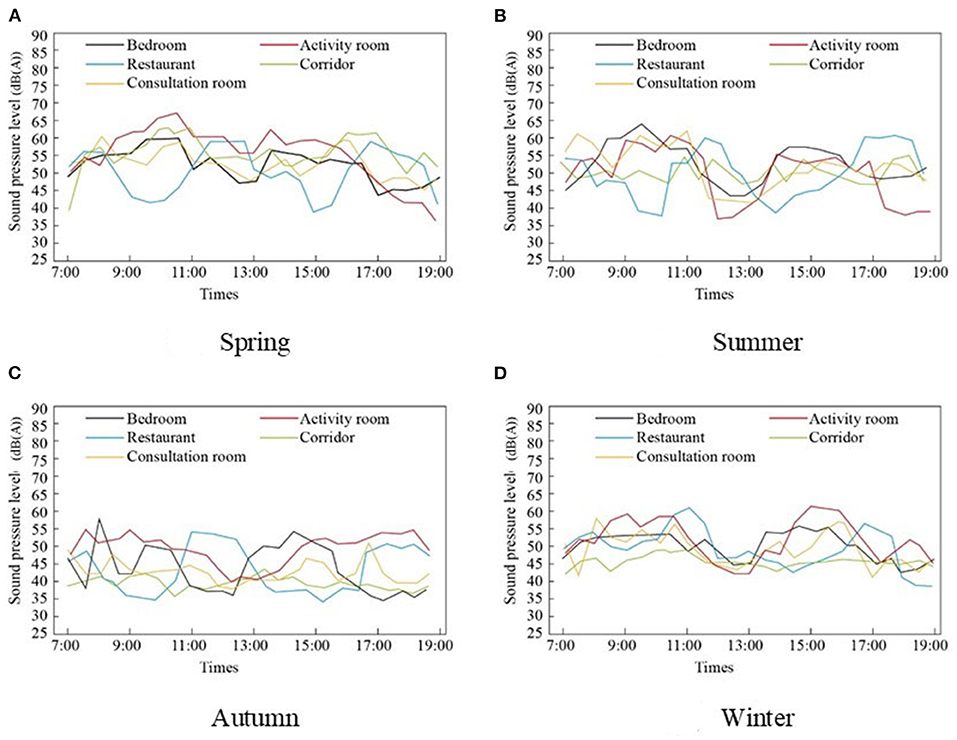
Figure 2. SPL measurement in different seasons and different rooms. (A) Spring, (B) Summer, (C) Autumn, and (D) Winter.
According to the Chinese industry standard “Architectural Design Standards for Elderly Care Facilities JGJ450-2018,” where the occupants are elderly, have excellent sound insulation and noise prevention devices, the noise in the living environment should be <40 dB(A), the air sound insulation should not be <50 dB(A), and the impact sound should not exceed 75 dB(A) (37). The noise levels of the RECFs in this study were slightly higher than stipulated, with a median level between 50 dB(A) and 60 dB(A). This difference may depend on specific sound sources in each RECF, the different behaviors of employees and the elderly, and traffic noise (38). Additionally, some employees occasionally walking in corridors can generate noise (for example, night shifts or caring for the elderly) (38). From this perspective, the surveyed RECFs need to strengthen noise control.
According to the evaluation results (Figure 3), the acoustic comfort level scores of bedrooms, activity rooms, restaurants, and corridors are almost all lower than 5 points in the four seasons, indicating that the acoustic environment of these types of rooms is poor.
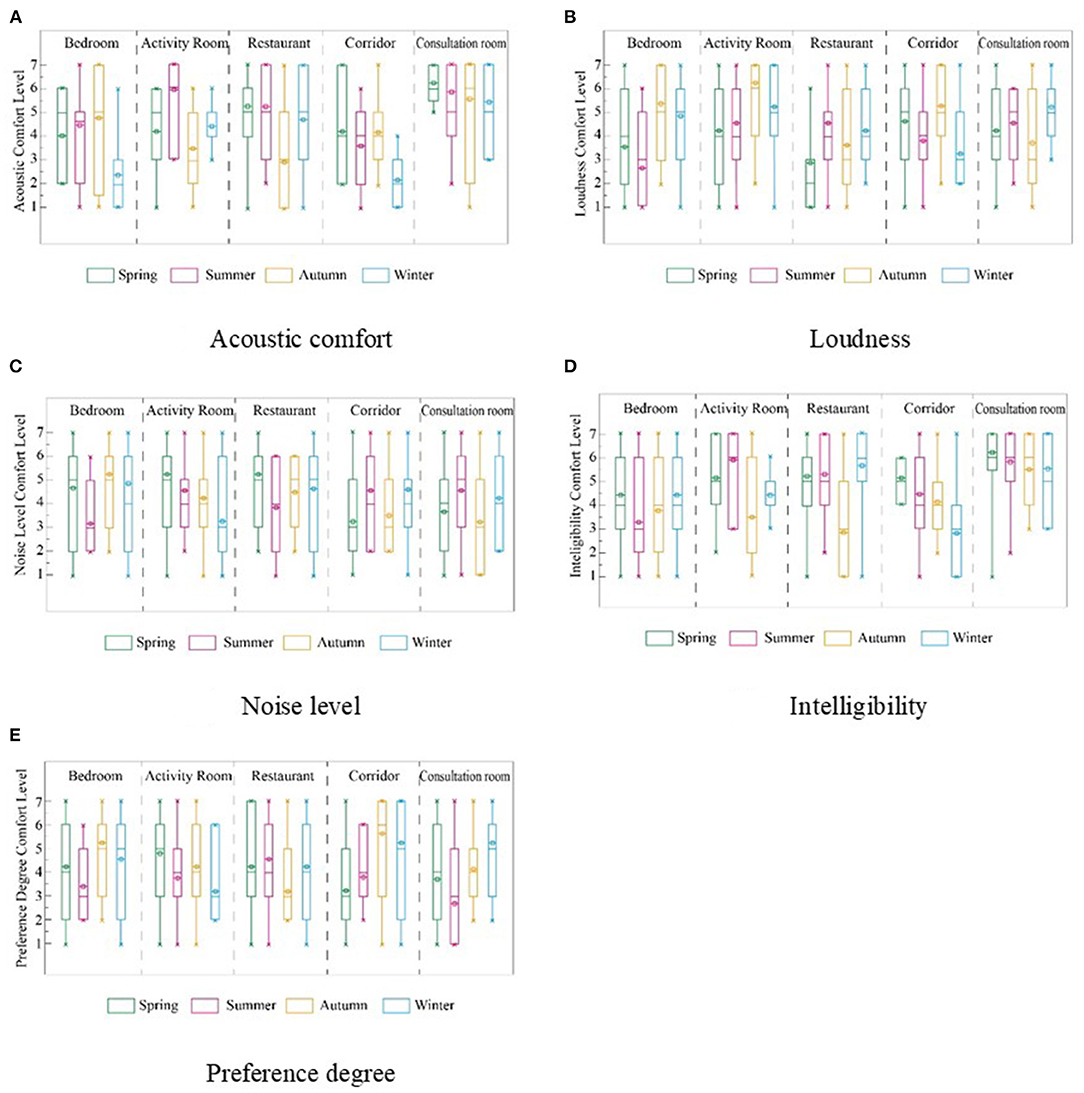
Figure 3. Evaluation of acoustic indicators of 4 RECFs based on seasonal differences. (A) Acoustic comfort, (B) Loudness, (C) Noise level, (D) Intelligibility, and (E) Preference degree.
Generally, the acoustic environment of the four RECFs was evaluated at a medium level (3.5–5 points). According to the seasonal change survey, there was no obvious change trend for acoustic indicators, nor were the evaluation results in bedrooms and activity rooms affected by seasonal changes. Autumn's assessment value was more than 1% lower than those in summer and winter. This was because when the survey was conducted in autumn, the surrounding buildings were under construction, and the resulting noise affected the evaluation of the acoustic environment. The overall acoustic environment change was not significantly affected by room type and season, but the overall score was not high; therefore, the acoustic environment of RECF should be strengthened.
The result of the linear relationship between the acoustic evaluation and SPL indicates that regardless of the season or room, the acoustic evaluation decreases as the SPL increases (Figure 4). The linear relationship between the SPL and acoustic evaluation of different types of rooms shows different trends with seasonal changes. The linear relationship between the SPL in the bedroom and restaurant and acoustic evaluation was poor. The linear relationship between corridor SPL and acoustic evaluation was better in spring, summer, and autumn (R-square > 0.7, p < 0.01) and worse in winter (R-square = 0.432, p < 0.01). The linear relationship between the SPL of the consultation room and acoustic evaluation shows little seasonal variation (R-square between 0.522 and 0.712, p < 0.01).
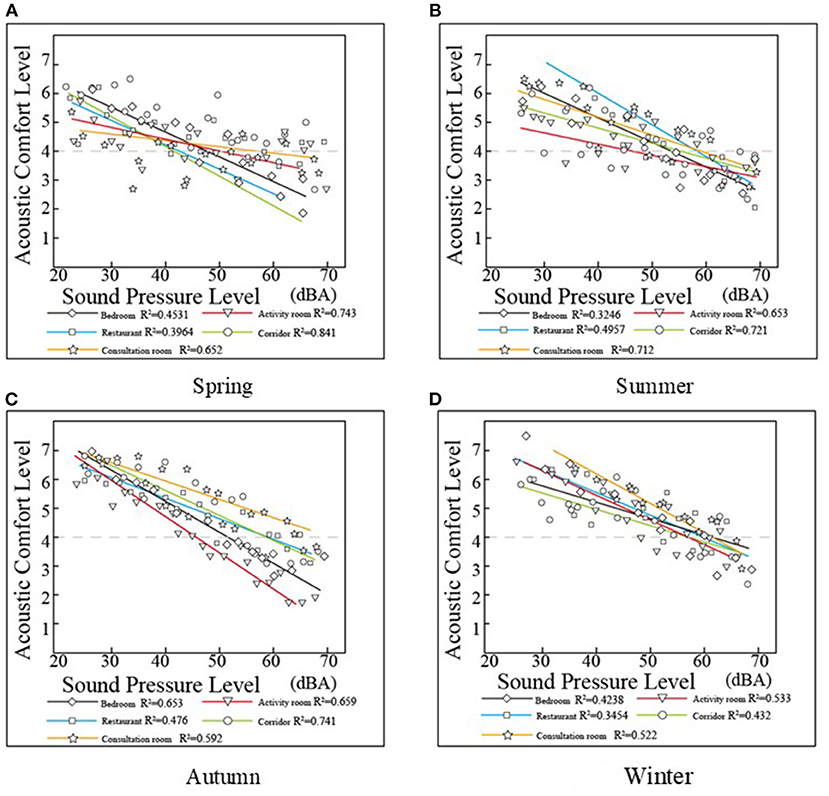
Figure 4. Fitting between SPL and acoustic evaluation based on seasonal differences. (A) Spring, (B) Summer, (C) Autumn, and (D) Winter.
An evaluation value exceeding four points indicates that the participants were satisfied with the surrounding physical environment. In summer, they generally expressed dissatisfaction with the acoustic environment when the SPL exceeded 65 dB(A). The SPL requirements were slightly higher in autumn and winter, and when the level reached 60 dB(A), they expressed dissatisfaction. For bedrooms and activity rooms, the satisfactory level was between 60 dB and 65 dB(A). When the noise level exceeds 70 dB(A), the acceptance of noise is greatly reduced, and the elderly express dissatisfaction (39).
In this study, the acoustic levels in the bedrooms and activity rooms were all higher than the recommended values. The noise generated could originate from floor contact noise (38). Additionally, some staff members occasionally move around and produce noise (38). When most of the elderly were in an activity room or outdoors, the noise level in the bedrooms was reduced. The relationship between the SPL in the bedroom and restaurant and the acoustic evaluation is poor (R-squared < 0.653, p < 0.01), and research on the relationship between the SPL in the bedroom and restaurant and the satisfaction of the acoustic environment should be further strengthened to meet the acoustic environment needs of the elderly.
As shown in Figure 5, the illuminance and brightness values of the five types of rooms showed a trend of first increasing and then decreasing, but their respective peaks varied with the seasons. Illuminance peaks in the bedrooms and restaurant occurred between 9:00 and 11:00. The overall brightness in the summer and autumn was higher than that in the spring and winter. According to previous investigations, the activity of the elderly peaks in the morning and before lunch, which was considered in the RECF design. Lighting is usually affected by weather, building location, and orientation. For the elderly who like reading and indoor activities, lighting directly affects their quality of life (40). Seasonal effects also lead to differences in lighting in the RECFs.
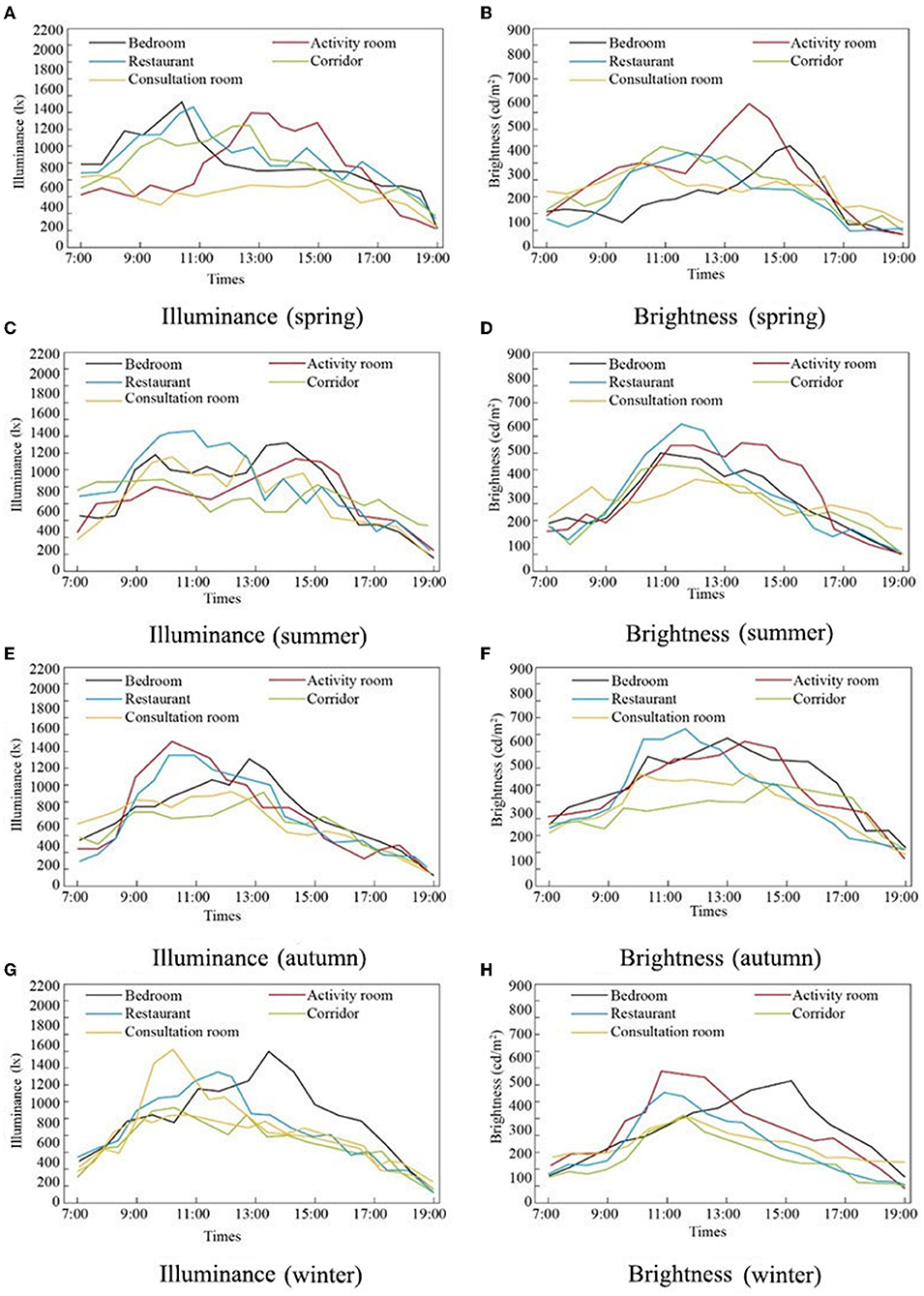
Figure 5. Illuminance and brightness measurement in different seasons and different rooms. (A) Illuminance (spring), (B) Brightness (spring), (C) Illuminance (summer), (D) Brightness (summer), (E) Illuminance (autumn), (F) Brightness (autumn), (G) Illuminance (winter), and (H) Brightness (winter).
The most direct environmental factor affecting the comfort of the elderly is the lighting intensity of the room. According to a Japanese company's research, the overall comfortable illuminance of the room varies from 50 to 250 lx for the elderly; the comfortable illuminance value for younger people accounts for approximately 2/3 of this illuminance, demonstrating that the elderly have a higher demand for lighting (41). In this study, the measured illuminance and brightness were inconsistent. This may be related to the survey season of these RECFs, construction time, structure of the building, and choice of construction materials (42).
The evaluation of lighting in the bedroom and consultation room was significantly affected by the season (Figure 6). From the perspective of the seasonal changes, it can be seen that the lighting environment evaluation in summer was higher than that in autumn and winter. The lighting environment evaluation was approximately 4.7, 4.0, and 3.9 in summer, winter, and autumn, respectively.
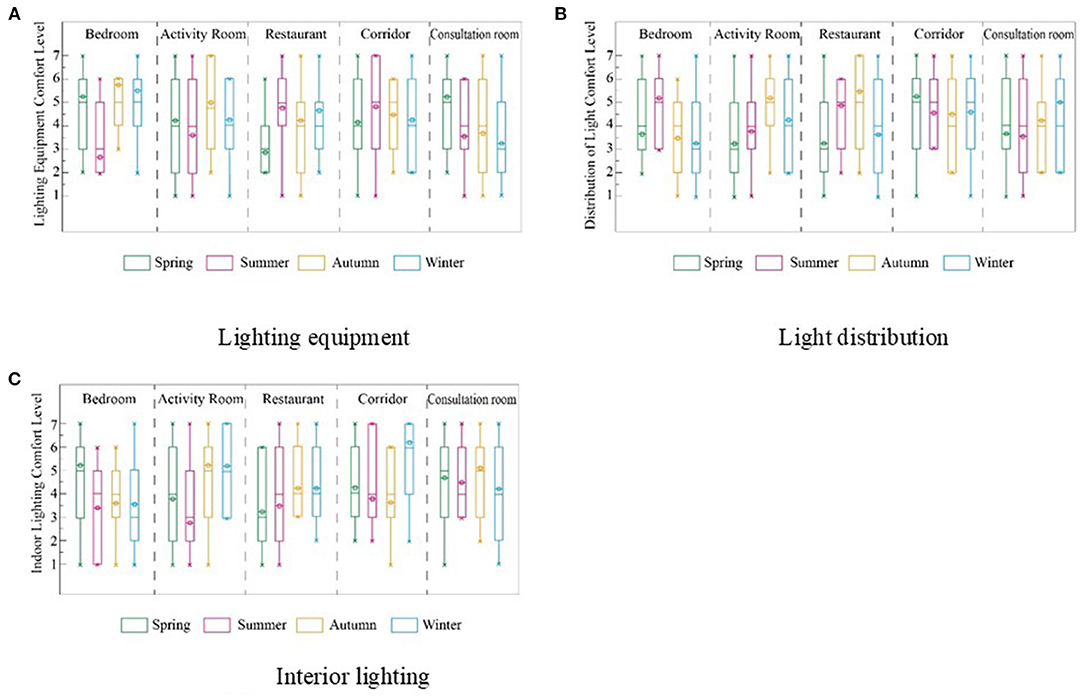
Figure 6. Evaluation of lighting factors of 4 RECFs based on seasonal differences. (A) Lighting equipment, (B) Light distribution, and (C) Interior lighting.
As a high-latitude region, Harbin experiences long days of sunshine in summer, with sufficient sunlight to compensate for the lack of indoor lighting distribution. The average lighting evaluation of the bedroom was 4.5, and the average lighting evaluation of the activity room was 3.5. The evaluation of lighting and lighting distribution in bedrooms was better than that in activity rooms because participants could control the lighting in the bedroom.
Lighting can be adapted to occupants' needs, increasing the happiness index of the elderly and supplementing dim lighting in winter. Mitsuhashi et al. reported the feasibility of using high-intensity artificial light for phototherapy in RECFs and measured the distribution of horizontal illuminance in major public spaces during winter. The horizontal illuminance of the elderly exceeds 2000 lx (43). Changes in vision associated with aging are among the most important physical changes, and the elderly need less lighting than younger adults to perform the same tasks (42, 44). In summer, the corresponding satisfaction is higher because sunlight can supplement lighting. The RECF should strengthen the lighting in spring, autumn, and winter to meet the needs of the elderly for the lighting environment.
The lighting indices include brightness and illuminance, which have a nonlinear relationship with the lighting evaluation (Figure 7). It can be seen from the figure that within a certain range, with the increase in brightness and illuminance, the evaluation of brightness and illumination also increases. After a certain limit, with the increase in brightness and illuminance, its evaluation begins to decrease. The linear relationship between bedroom brightness and brightness evaluation was poor (R-squared between 0.314 and 0.418, p < 0.01). With changes in spring, summer, autumn, and winter, the linear relationship between the illumination of the consultation room and its evaluation gradually improved (R-squared from 0.456 to 0.703, p < 0.01).
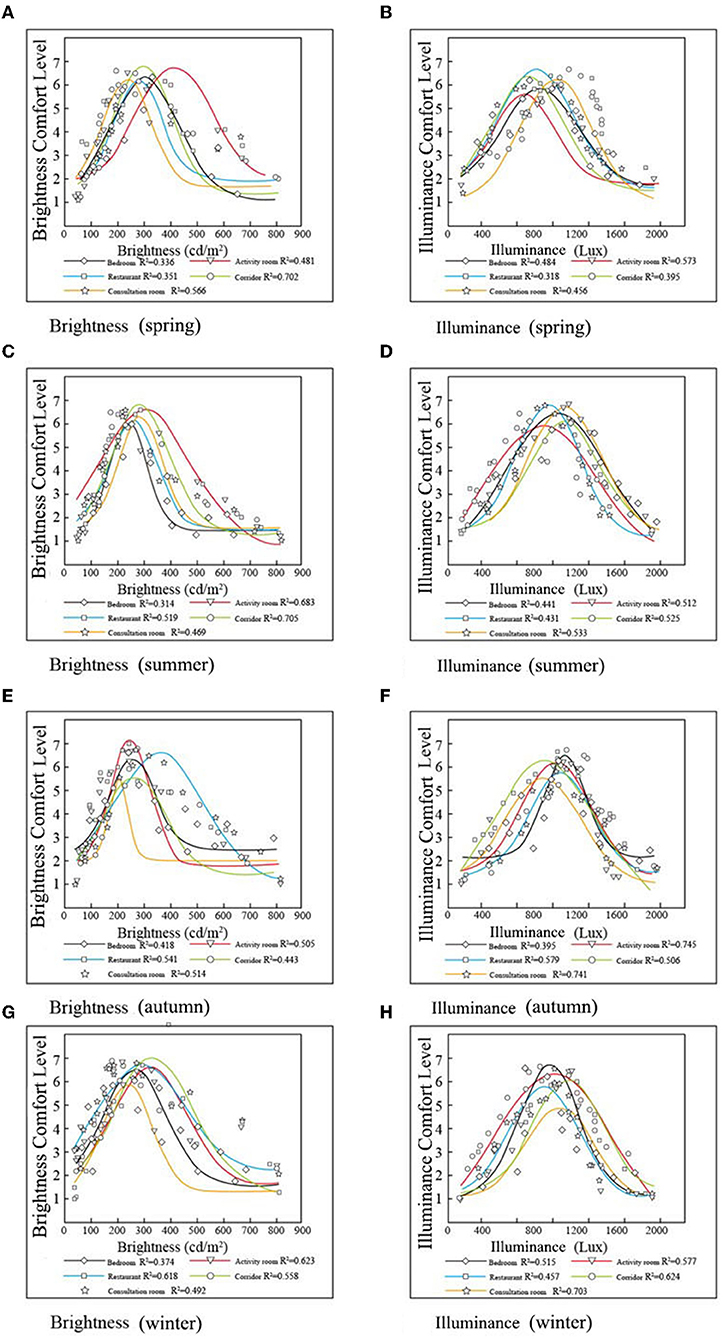
Figure 7. The fit between lighting indicators and lighting evaluation for 4 RECFs. (A) Brightness (spring), (B) Illuminance (spring), (C) Brightness (summer), (D) Illuminance (summer), (E) Brightness (autumn), (F) Illuminance (autumn), (G) Brightness (winter), and (H) Illuminance (winter).
The evaluation of the brightness comfort level and illuminance comfort level by the elderly showed significant differences between the measured rooms (p < 0.01). The elderly preferred significantly less brightness in autumn and winter, while less illuminance was preferred in spring and summer (Figure 7, p < 0.01). The thresholds of the bedrooms and activity rooms were similar, with participants satisfied with an illuminance of <1000 lx. However, in an ordinary room, most of the measured values of vertical and horizontal illuminance were much lower than the reference value of 750 lx, and the illuminance of the corridor was <200 lx (45). The illuminance of the RECFs investigated in this study was higher than the reference value of 750 lx, as indicated by Sinoo in the Netherlands (42). The illuminance and brightness thresholds for the RECFs are not stipulated in official international documents.
In summary, the four RECFs we surveyed met participants' lighting needs. Turner et al. pointed out that insufficient lighting may aggravate insomnia in the elderly population. A lighting threshold of 2,500–3,000 lx has been proven to reduce insomnia in the elderly and improve total sleep time (46). From this perspective, although the main resting space of the elderly is the bedroom, the lighting in ordinary rooms is also critical to the daily activities of the elderly. The corridor was the center of each room. If lighting conditions are poor, the elderly may be in danger of falling. Therefore, RECF should consider the lighting conditions of corridors and other areas that are usually overlooked.
As shown in Figure 8, the temperature fluctuations of the five types of rooms during the four seasons were small, indicating that the RECFs selected in this study were better for indoor temperature control.
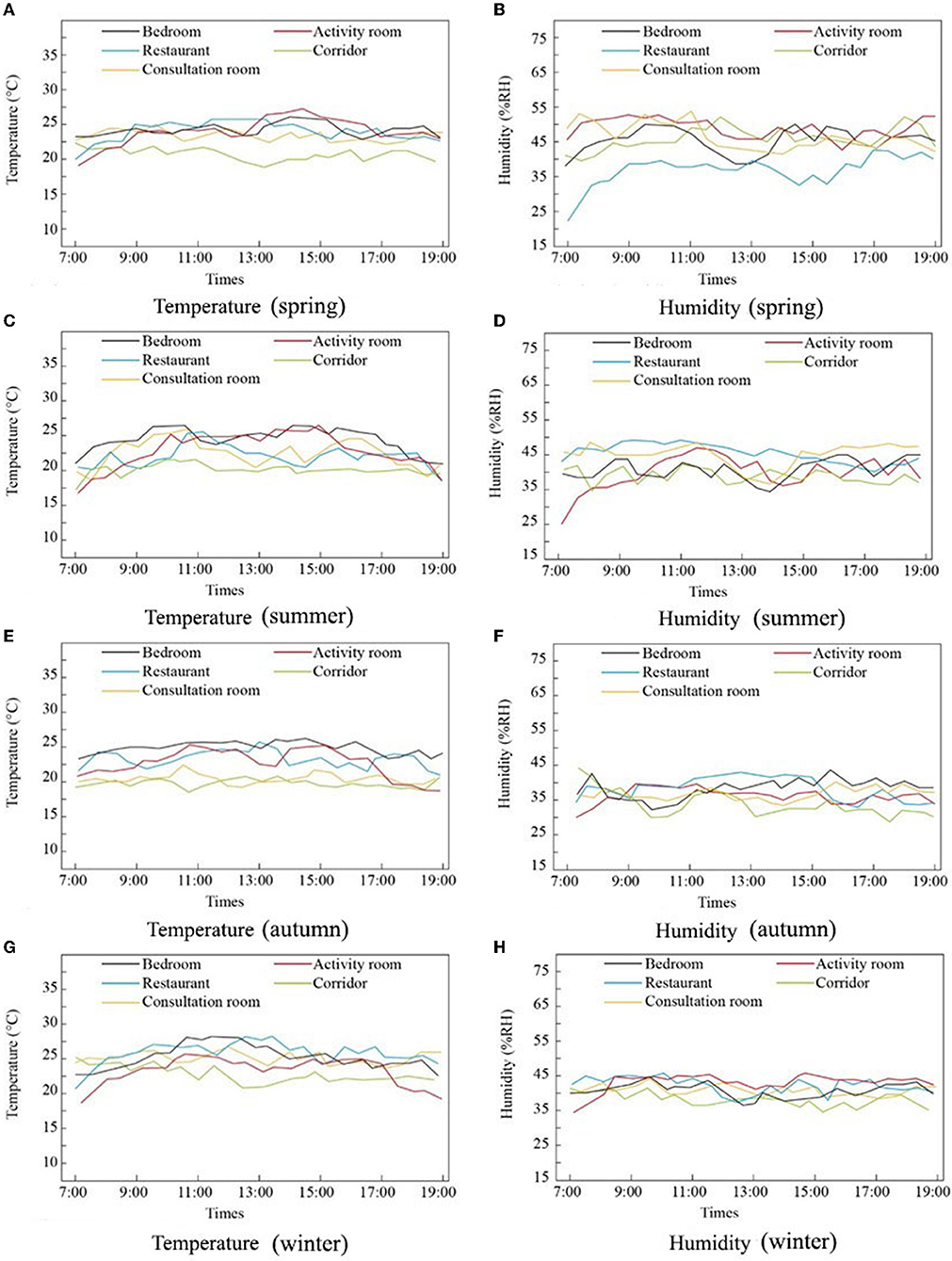
Figure 8. Temperature and Humidity measurement in different seasons and different rooms. (A) Temperature (spring), (B) Humidity (spring), (C) Temperature (summer), (D) Humidity (summer), (E) Temperature (autumn), (F) Humidity (autumn), (G) Temperature (winter), and (H) Humidity (winter).
Temperature and humidity are key indicators for assessing room comfort. The temperature measurements showed no obvious differences between the active rooms and bedrooms. In line with the findings of some previous studies (47), our research found that the humidity in the activity rooms was higher than that in the bedrooms.
Maintaining air comfort in RECFs is important, but requires consideration of the activities of the elderly. Related research has indicated that in the absence of physical activity, the indoor temperature should be close to 25°C; in the case of physical activity, it should be lowered but remain higher than 20°C. Humidity should be maintained between 25 and 55% (48). Additionally, according to T18883–2002, the standard temperatures for heating in winter should fall within 16–24°C and for air conditioning in summer should be 22–28°C (49). The temperatures in this study were either higher or lower than the recommended temperatures in summer and winter.
Our research analyzed three thermal environment indicators (temperature, relative humidity, and ventilation) of different RECFs and their correlation with the IEQ (Figure 9). The results demonstrate that the elderly were satisfied with their RECF thermal environment, and almost all the temperature and ventilation evaluations exceeded four points.
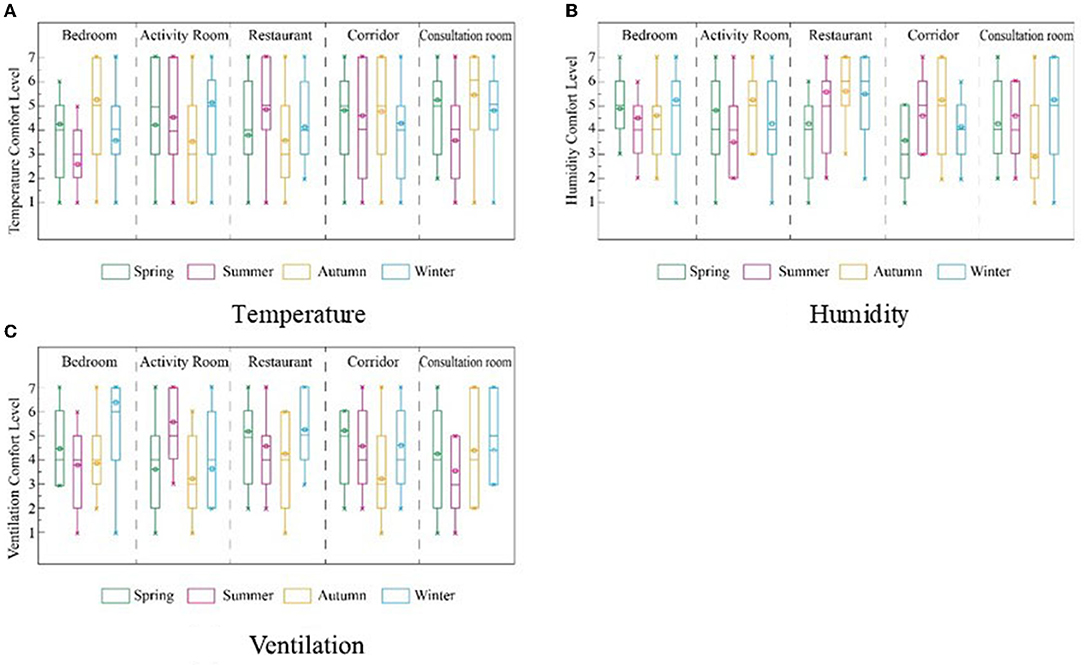
Figure 9. Evaluation of thermal factors of 4 RECFs based on seasonal differences. (A) Temperature, (B) Humidity, and (C) Ventilation.
The temperature evaluation of the bedroom, corridor, and consultation room showed a similar trend to seasonal changes; that is, the evaluation in summer was significantly lower than that in spring, autumn, and winter. The temperature evaluation of active rooms and restaurants showed a similar change trend with seasons; that is, the evaluation in summer was higher than that in spring and autumn (Figure 9A).
The humidity evaluation of the five types of rooms showed no obvious regularity with season (Figure 9B). As the elderly can often open windows or doors at will, the bedroom ventilation is highly rated (Figure 9C). Because ventilation in activity rooms cannot meet everyone's needs, there are differences between the RECFs. Generally, however, they evaluated the ventilation in autumn as low. The analysis of the amount of ventilation and humidification required in winter indicated that the variety of ventilation methods of each facility, such as opening windows and living room doors, is closely related to building performance: the colder the area, the more the ventilation increases (50). Overall, the elderly in this study had higher satisfaction with the thermal environment of RECF. Further research should focus on ventilation in activity rooms.
There was a good fit between the seasonal temperature and thermal environment evaluation (Figure 10). For all the RECFs, the threshold did not vary greatly depending on the season or room, and the elderly were satisfied with temperatures between 25 and 26.5°C. Regardless of room or season, a humidity of 40–45% was most comfortable for the elderly. There were significant differences between the evaluation values of temperature and humidity in the five rooms (p < 0.01).
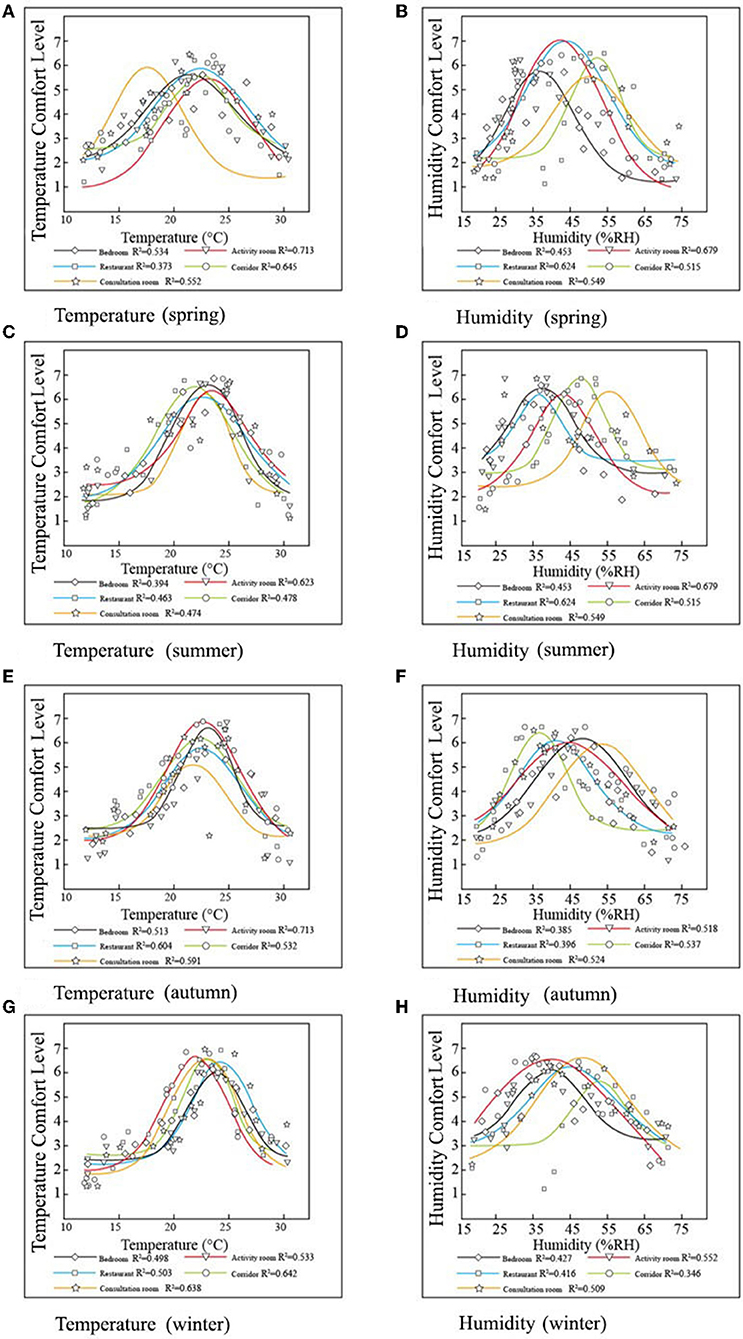
Figure 10. The fit between thermal indicators and thermal evaluation for 4 RECFs. (A) Temperature (spring), (B) Humidity (spring), (C) Temperature (summer), (D) Humidity (summer), (E) Temperature (autumn), (F) Humidity (autumn), (G) Temperature (winter), and (H) Humidity (winter).
Unlike the results of Taleghani et al. and Jin et al. (51, 52), our results indicate that the elderly prefer a drier environment, with some interviewees stating that high humidity makes them feel breathless, hot, and stuffy.
Physically and psychologically, elderly prefer warm environments. For sedentary elderly individuals, the best temperature is approximately 25.3°C. The temperature range is 16–25°C in winter and 22–31°C in summer (53). The satisfaction of the elderly with temperature and humidity in summer is lower than that in other seasons, indicating that the temperature and humidity control of RECF in Northeast China is still lacking in terms of seasonal replacement.
As shown in Figure 11, the CO levels in all five rooms were relatively stable. The CO levels were below 8 ppm in all four seasons, meeting the national safety standards. The CO2 content in the different types of rooms showed different trends. The CO2 levels in the corridors and consultation rooms varied less over the time of the day (approximately 400 ppm) and were stable across seasons. The CO2 concentration in the bedroom and restaurant generally peaks at 11:00–13:00, whereas the peak CO2 concentration in the activity room generally occurs between 9:00 and 10:00 in the morning and between 14:00 and 16:00 in the afternoon (Figure 11). This finding is consistent with the life and rest rules of the elderly population. The oxygen content of the five types of rooms was relatively stable. In the four seasons, the oxygen content fluctuated around 21%, which was in line with the normal standard.
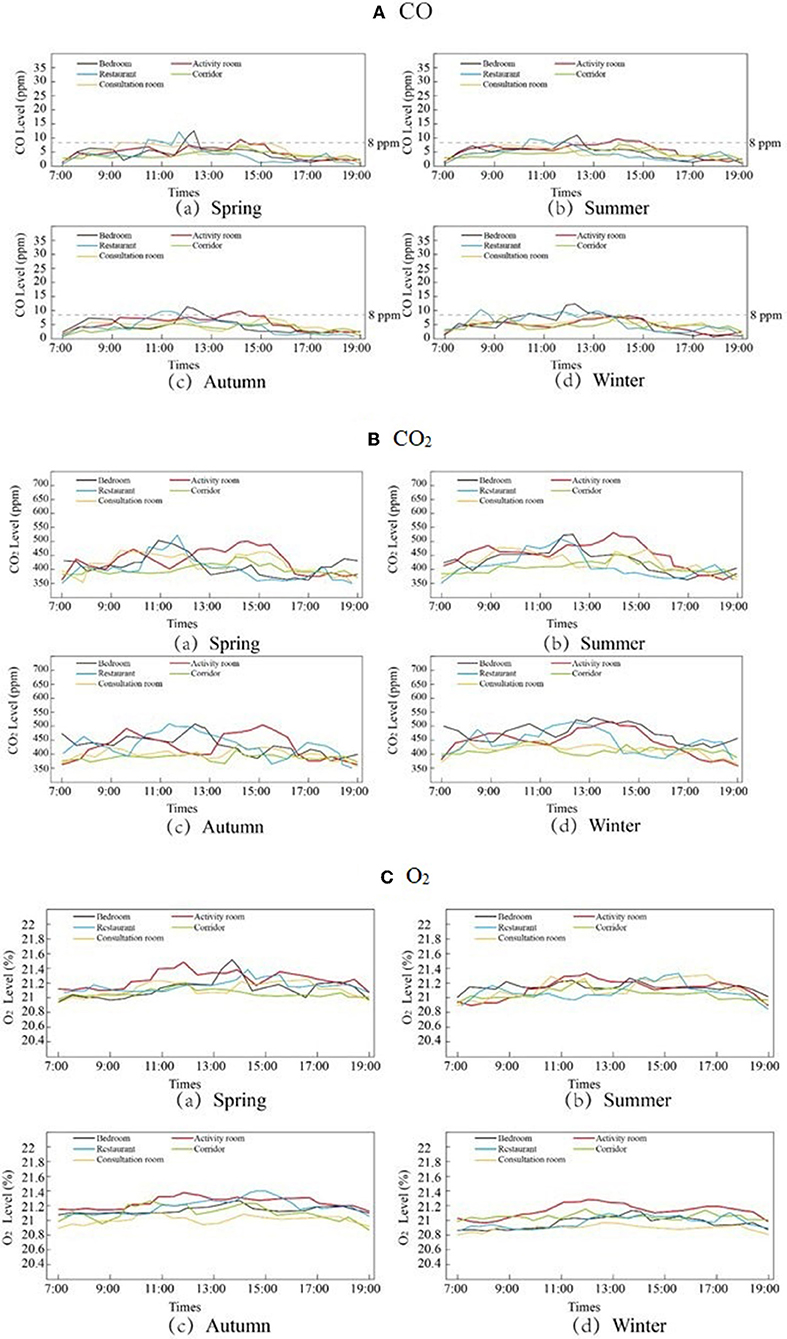
Figure 11. CO CO2 and O2 measurement in different seasons and different rooms. (A) CO, (B) CO2, and (C) O2.
As people spend more than 90% of their time indoors, IAQ is important (54). In the survey, IAQ evaluation included odor, freshness, and cleanliness (Figure 12). As a result, the elderly are less sensitive to odors and correlate poorly with overall IEQ assessments, even though living environment odors are critical to the health of the elderly. Research on IAQ in facilities for the elderly has an important impact on their quality of life and health. Mendes et al. evaluated IAQ in the urban elderly care center (ECC) of 425 elderly individuals in Porto, Portugal, and found that fungal concentrations often exceeded reference levels. In addition, other pollutants exceeded the reference levels (55). Bedrooms and playrooms are places where seniors often spend their time. Moreover, the activity room is relatively crowded, and the IAQ is worse. Therefore, targeted IAQ improvement measures should be implemented for different types of rooms.
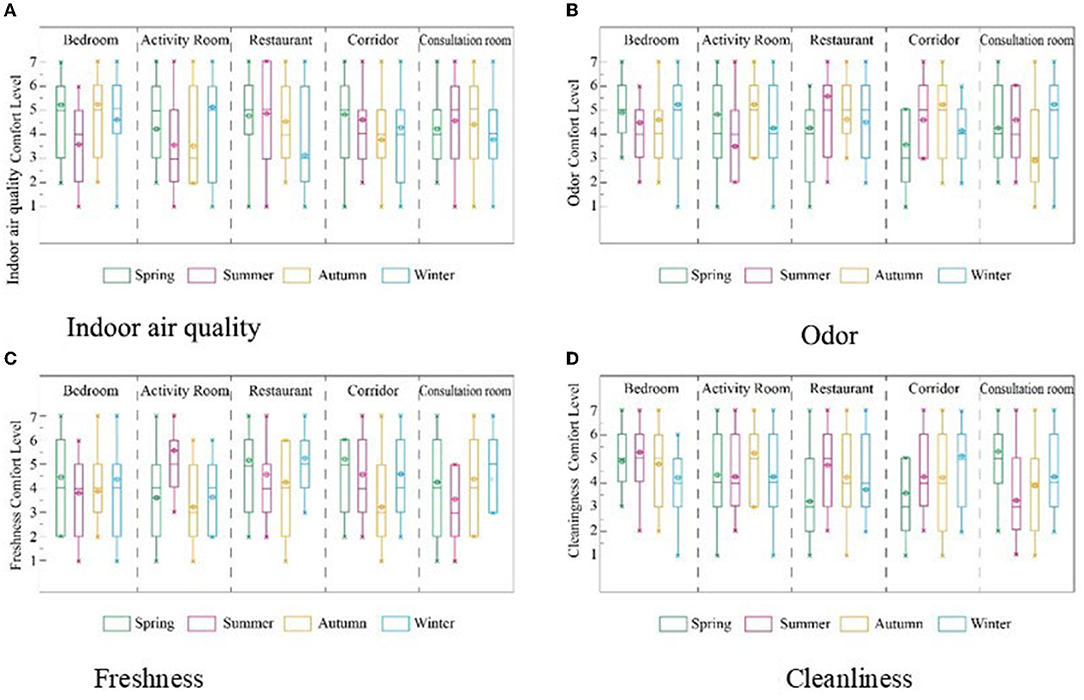
Figure 12. Evaluation of air quality of 4 RECFs based on seasonal differences. (A) Indoor air quality, (B) Odor, (C) Freshness, and (D) Cleanliness.
To study the influence of physical environment on the overall IEQ evaluation, we first analyzed the correlation between different physical environments and the overall IEQ (see Table 3). The elderly had a good overall IEQ evaluation of the four physical environmental parameters, all of which exceeded 4.5 points (out of seven). The four selected physical environment parameters had a high positive correlation with the overall IEQ evaluation and a strong influence on IEQ, with all correlation coefficients close to or above 0.7 (p < 0.001; see Table 3).
The four IEQ factors were further studied to evaluate the physical environmental parameters of the RECFs comprehensively (Table 4). In Table 4, column A shows the mean evaluation and standard deviation of the four factors of the elderly in different types of rooms.
Activity rooms and restaurants had the highest ratings, with close to five points. For corridor, the scores for acoustics, lighting, and IAQ were lower than four points. The lower corridor evaluation (from Column B) might be due to poor acoustic and lighting environments because their correlation with IEQ evaluation was as high as 0.826 and 0.701 (p < 0.001). The IEQ evaluations of the other five types of rooms have a high correlation with the four physical parameters, with correlation coefficients of between 0.66–0.85 (p < 0.001).
This study found that seasonal changes affected IEQ satisfaction. Autumn had the highest IEQ evaluation, with all four factors being close to five points (p < 0.01). Participants generally indicated that spring and autumn were more comfortable than summer and winter (see Table 5), perhaps because the elderly prefer the climate in spring and autumn. Particularly in the IAQ evaluation, the spring (5.183) and autumn (5.071) evaluations were significantly higher than the summer (4.179) and winter (4.113) evaluations (p < 0.01). The reason for the high IEQ satisfaction during autumn might be the suitable thermal environment in autumn, warming in spring, and the end of the hot summer in autumn. However, the frequent opening of windows in the summer can cause outdoor traffic noise and air pollution. The abundance of sunshine in summer may be pleasant for the elderly, but too bright a light can affect their actions. However, lack of sunlight in winter can also affect the activities of the elderly (56). For example, Sinoo et al. found that in seven RECFs, at least three-quarters of the measurements had corridor brightness significantly below the 200 lx threshold (42). Therefore, in winter, or when there is insufficient lighting, the RECF lighting environment should be considered. Mishima et al. also demonstrated that we need to consider the elderly who suffer from poor environmental lighting, leading to disorganized circadian rhythms (57). Therefore, in winter, or when there is insufficient lighting, the RECF lighting environment should be considered. For different room types, the bedrooms were more comfortable than activity rooms based on the evaluation, perhaps because bedrooms are private spaces and residents have more freedom to open windows, close doors, or pull curtains according to their preferences. The relative advantages and costs of private bedrooms are controversial, especially given the current commitment to creating cost-effective and people-centered care facilities. Similar to our results, Calkins et al. also found that bedrooms are better than shared activity rooms in RECFs (58).
IEQ satisfaction has a significant relationship with people's background (59–63). This background includes physiological factors such as gender and age; social factors such as education, retirement, and marital status; and lifestyle factors such as residence time and place of origin. This section includes an analysis of the impact of these factors on the IEQ satisfaction of the elderly based on all RECF surveys. Seven personal and social factors that may affect IEQ satisfaction (Table 6) were selected. In general, gender differences had no significant impact on IEQ factor evaluation, while residence time and marital status had an impact (p < 0.01). Age and education had a significant effect on all IEQ factors except temperature (p < 0.01). The following subsections discuss the impact of personal and social factors on IEQ evaluation.
This study explored the effects of different age groups on lighting, acoustics, and IAQ. The evaluations of the under-65 and over-85 groups were similar, with ratings of the lighting environment, acoustic environment, and IAQ higher. However, the two 65–85-year groups rated humidity evaluation and odor evaluation higher, perhaps because those over 85 have poor physical functioning and relatively low sensitivity to the environment, making it difficult for them to perceive changes. In addition, some studies have shown that with an increase in age, the evaluation of the comfort of the acoustic environment of the elderly is increasing, indicating that the tolerance of the elderly to the acoustic environment is higher than that of the young (64). In our study, the 66–85-year age group also rated slightly lower than those aged 60–65 years (see Figure 13). As the light received by the retina decreases with age, the elderly require more lighting. After the age of 70 years, they have difficulty seeing some details, vision loss, and the lighting requirements increase after the age of 50 (44). Although most studies suggest that as the visual function of the elderly declines, lighting conditions have a greater impact on them. However, the study by Wang et al. showed that there were no significant differences in the subjective evaluations and ECG indicators of the elderly under different lighting conditions (65). The influence of lighting color on the elderly has gradually attracted attention. Studies have found that low-saturation lighting can help improve the mood and comfort of the elderly, and medium-high saturation lighting can affect thermal sensations in the elderly (66). Therefore, the RECF under investigation still needs to improve the lighting conditions. According to Indraganti and Peng's research results, there is no obvious correlation between age and thermal comfort, and gender and age have a minimal influence on thermal evaluation (67, 68). However, we found that the elderly were more sensitive to changes in humidity. This result is consistent with the findings of Jin et al. (69).
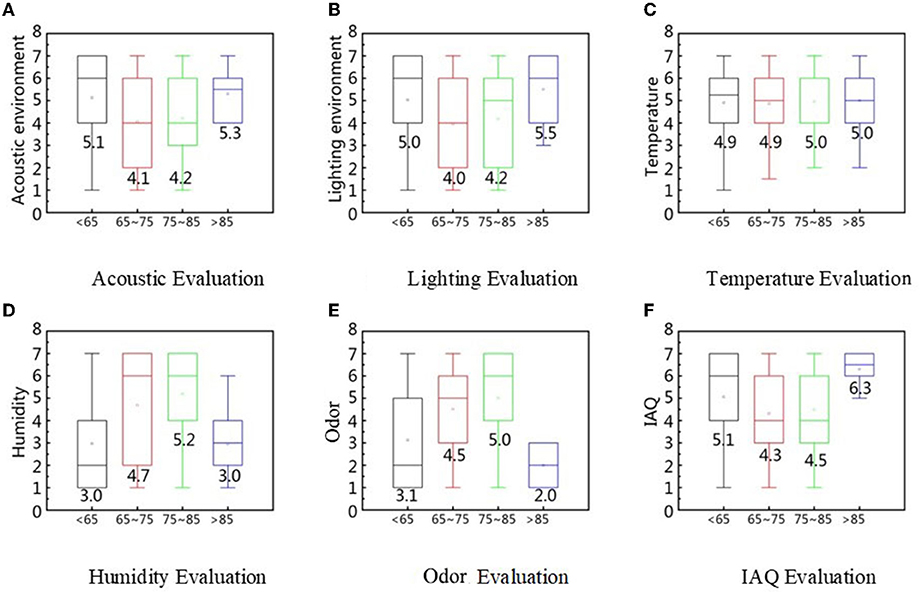
Figure 13. IEQ factors evaluation based on age difference. (A) Acoustic evaluation, (B) Lighting evaluation, (C) Temperature evaluation, (D) Humidity evaluation, (E) Odor evaluation, and (F) IAQ evaluation.
As shown in Figure 14, in a quiet environment, people with higher education and pension levels are more comfortable. By contrast, in a noisy environment, acoustic comfort decreases with an improvement in education level. Elementary school or below is classified as basic education, junior high school or high school as secondary education, and college degree or above as higher education. The boundary between quiet and noisy environments is an SPL of 60 dB(A) (70). The elderly with higher education had higher personal attainment and usually gave positive evaluations, whereas those with basic education had relatively low IAQ ratings (below four points). The evaluation of the elderly with secondary and higher education was higher than that of those with a basic education (p < 0.01). The elderly with basic education had relatively low IAQ scores (below four points). According to a survey by Guo et al., this difference comes from the respondents' different understandings of IAQ (71). They found that people with higher cultural backgrounds had higher evaluations of IAQ.
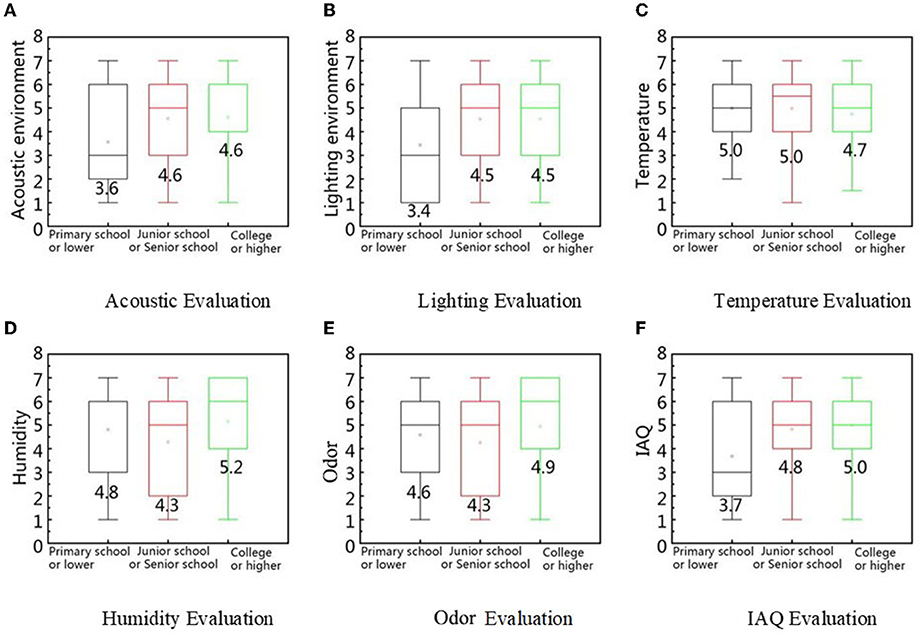
Figure 14. IEQ factors evaluation based on the difference in education level. (A) Acoustic evaluation, (B) Lighting evaluation, (C) Temperature evaluation, (D) Humidity evaluation, (E) Odor evaluation, and (F) IAQ evaluation.
The impact of pensions on the evaluation results was similar to that of education level (Figure 15). This is likely because basic education corresponds to a low pension (<2,000), and higher education to a high pension (>5,000). Elderly people with low pensions and basic education have stricter environmental requirements, and those with higher pensions and higher education have a higher tolerance for the environment. Similar to the present study, Cui et al. showed that with an increase in income, the elderly's evaluation of acoustic environment comfort decreases (64).
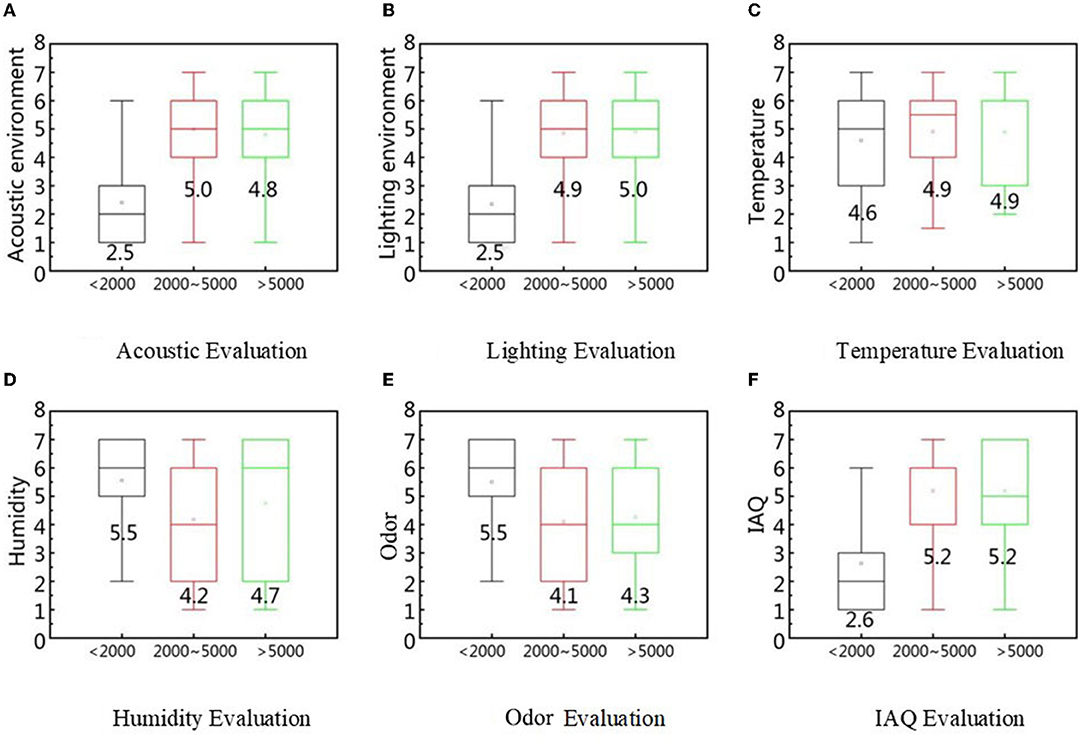
Figure 15. IEQ factors evaluation based on pension difference. (A) Acoustic evaluation, (B) Lighting evaluation, (C) Temperature evaluation, (D) Humidity evaluation, (E) Odor evaluation, and (F) IAQ evaluation.
Marital status can cause large differences in IEQ satisfaction (Supplementary Figure 6). Overall, divorced older adults had a higher IEQ rating than other groups; widowed older adults had an average IEQ rating of less than four points, and married older adults had a relatively stable evaluation of various factors, unlike the single group. However, in contrast to the findings of Cui et al. (64), our results demonstrate that the divorced elderly were more satisfied with the environment than the married elderly (p < 0.01), perhaps because the former are more likely to be emotionally suffering; the RECF environment increases their socialization, making up for the lack of a close relationship, greatly alleviating their cognitive impairment. Håkansson et al. demonstrated that unmarried (single, divorced, and widowed) people are more likely to have cognitive impairment than married people (72), which can create uncertainty in evaluating the surrounding environment.
Moreover, according to research by MOUSAVI-NASAB and others, married (and divorced) people will have strong episodic memory, which is good for the health of the elderly, while single and widowed people will have negative memory and cognition, impacting them in the long run (73). Therefore, in the IEQ, the scores of divorced and married older adults were higher than those of widowed and single individuals (p < 0.01).
The residence time also had an impact on IEQ evaluation. With increased time spent in RECFs, the IEQ evaluation also increased (Supplementary Figure 7). The elderly who had lived in RECFs for >3 years had an average evaluation score of five points, especially for the acoustic environment, lighting environment, and IAQ. Simultaneously, their long residence times indicated their satisfaction with the RECF environment. The satisfaction of the elderly with the IEQ increases with their residence time, perhaps because they are accustomed to living there. If they are more familiar with the living environment, they will have a higher evaluation of it (74).
The physical environments of the four RECFs were found to be highly correlated with IEQ evaluation, including acoustic, lighting, thermal environment, and IAQ (p < 0.01). The survey found that IEQ evaluations were affected by seasonality, with the evaluation of bedrooms being higher than that of activity rooms. A reasonable assessment of the surveyed RECF was moderate, while the elderly had a weaker understanding of intelligibility. The acoustic evaluation has a linear relationship with SPL and is not affected by the season or room. The lighting environment in summer is usually higher than that in winter and autumn, and the bedroom evaluation is usually higher than that of the activity room. Brightness and illuminance have a nonlinear relationship with lighting evaluation. The relative humidity of the different types of rooms varied greatly in spring and less in winter. IEQ satisfaction of all four RECFs was highly correlated with four physical parameters, with correlation coefficients of 0.66–0.85 (p < 0.001). Seasonal changes affected IEQ satisfaction, which was highest in autumn. The overall evaluation results demonstrated that in all four RECFs, bedrooms were more comfortable than activity rooms. It also indicates that the evaluation of the elderly of the RECF is not affected by gender; the effect of age is reflected in environmental factors other than temperature, and people under 65 and over 85 have the largest fluctuations in physical environment evaluation. Additionally, the elderly were satisfied with the overall IEQ environment of the RECFs.
This study investigated the environment of elderly care facilities where the elderly live, which will help improve the living environment of the elderly in the future. To the best of our knowledge, there is a lack of research on the living environment of RECFs, and the true scale of the problem is yet to be evaluated. We provide the first step toward bridging this gap.
This study summarized four RECF environments in the northeast region, representing the global cold zone from summer to winter in 2018. Statistical analyses were conducted on these data using specific site parameters and surveys of relevant elderly individuals. However, their satisfaction was still low, which may explain their unclear description, or it may be just abnormal data. These problems should be addressed in future research by exploring the potential impacts or mediating factors between various physical environmental evaluations.
In the future, the proportion of the elderly in China will further increase, and the elderly will have higher requirements for the indoor environment. The results of this study can be used to guide the renovation of existing facilities and the design of interior spaces in new ones. From the perspective of the impact of the acoustic environment, lighting environment, thermal environment, and IAQ on the elderly, the elderly care environment in Northeast China should be optimized. In addition, the elderly may have different environmental needs for different types of rooms. For example, in the bedroom, acoustic and lighting environments interact more closely with the health status of the elderly. In an activity room, IAQ may be a more important factor for the elderly. Therefore, research on the interaction between the indoor environment and the health and condition of the elderly is very important to improve their lives.
The original contributions presented in the study are included in the article/Supplementary Material, further inquiries can be directed to the corresponding author.
JM and JK contributed to conception and design of the study and wrote sections of the manuscript. JM organized the database, performed the statistical analysis, and wrote the first draft of the manuscript. Both authors contributed to manuscript revision, read, and approved the submitted version.
This work was supported by the National Natural Science Foundation of China (NSFC; grant number: 51778169), China Association for Science and Technology Think Tank Young Talents Program 2021 (grant number: 2021ZZZLFZB1207149), and Ministry of Science and Technology of China (grant number: G2021179030L).
The authors declare that the research was conducted in the absence of any commercial or financial relationships that could be construed as a potential conflict of interest.
All claims expressed in this article are solely those of the authors and do not necessarily represent those of their affiliated organizations, or those of the publisher, the editors and the reviewers. Any product that may be evaluated in this article, or claim that may be made by its manufacturer, is not guaranteed or endorsed by the publisher.
The authors would like to thank 51runse (www.51runse.cn) for the English language editing during the preparation of this manuscript.
The Supplementary Material for this article can be found online at: https://www.frontiersin.org/articles/10.3389/fpubh.2022.860976/full#supplementary-material
1. Winker MA, Glass RM. The aging global population: a call for papers. J Am Med Dir Assoc. (1996) 276:1758. doi: 10.1001/jama.1996.03540210066037
2. Leung M, Wang C, Chan IYS. A qualitative and quantitative investigation of effects of indoor built environment for people with dementia in care and attention homes. Build Environ. (2019) 157:89–100. doi: 10.1016/j.buildenv.2019.04.019
3. Huang Y, Chu C, Lee SC, Lan S, Hsieh C, Hsieh Y. Building users' perceptions of importance of indoor environmental quality in long-term care facilities. Build Environ. (2013) 67:224–30. doi: 10.1016/j.buildenv.2013.05.004
4. Pei Z, Lin B, Liu Y, Zhu Y. Comparative study on the indoor environment quality of green office buildings in China with a long-term field measurement and investigation. Build Environ. (2015) 84:80–8. doi: 10.1016/j.buildenv.2014.10.015
5. Mujan I, Andelkovic AS, Muncan V, Kljajic M, Ruzic D. Influence of indoor environmental quality on human health and productivity - A review. J Clean Prod. (2019) 217:646–57. doi: 10.1016/j.jclepro.2019.01.307
6. Lin L-Y, Chuang H-C, Liu IJ, Chen H-W, Chuang K-J. Reducing indoor air pollution by air conditioning is associated with improvements in cardiovascular health among the general population. Sci Total Environ. (2013) 463–464:176–181. doi: 10.1016/j.scitotenv.2013.05.093
7. Baloch RM, Maesano CN, Christoffersen J, Banerjee S, Gabriel M, Csobod É, et al. Indoor air pollution, physical and comfort parameters related to schoolchildren's health: Data from the European SINPHONIE study. Sci Total Environ. (2020) 739:139870. doi: 10.1016/j.scitotenv.2020.139870
8. Stansfeld S, Matheson M. Noise pollution: non-auditory effects on health. Br Med Bull. (2003) 68:243–57. doi: 10.1093/bmb/ldg033
9. Kerns E, Masterson EA, Themann CL, Calvert GM. Cardiovascular conditions, hearing difficulty, and occupational noise exposure within US industries and occupations. Am J Ind Med. (2018) 61:477–91. doi: 10.1002/ajim.22833
10. Du X. Investigation of indoor environment comfort in large high-speed railway stations in Northern China. Indoor Built Environment. (2020) 29:54–66. doi: 10.1177/1420326X19842299
11. Gao J, Barroso C, Zhang P, Kim H-M, Li S, Labrador L, et al. N-terminal acetylation promotes synaptonemal complex assembly in C. elegans. Genes Dev. (2016) 30:2404–16. doi: 10.1101/gad.277350.116
12. Shochat T, Martin J, Marler M, Ancoli-Israel S. Illumination levels in nursing home patients: effects on sleep and activity rhythms. J Sleep Res. (2000) 9:373–9. doi: 10.1046/j.1365-2869.2000.00221.x
13. Hamel KA, Okita N, Higginson JS, Cavanagh PR. Foot clearance during stair descent: effects of age and illumination. Gait Posture. (2005) 21:135–40. doi: 10.1016/j.gaitpost.2004.01.006
14. Wei L, Chunyu Y, Zhonglin C. Luminous environment in living room for the elderly. China Illum Eng J. (2013) 3:14–7.
15. Alpérovitch A, Lacombe J-M, Hano n O, Dartigues J-F, Ritchie K, Ducimetière P, et al. Relationship between blood pressure and outdoor temperature in a large sample of elderly individuals: the Three-City study. Arch Intern Med. (2009) 169:75–80. doi: 10.1001/archinternmed.2008.512
16. Aghamolaei R, Ghaani MR. Balancing the impacts of energy efficiency strategies on comfort quality of interior places: Application of optimization algorithms in domestic housing. J Build Eng. (2020) 29. doi: 10.1016/j.jobe.2020.101174
17. Belmonte JF, Barbosa R, Almeida MG. CO2 concentrations in a multifamily building in Porto, Portugal: Occupants' exposure and differential performance of mechanical ventilation control strategies. J Build Eng. (2019) 23:114–26. doi: 10.1016/j.jobe.2019.01.008
18. Li W, Zhang J, Zhao T. Indoor thermal environment optimal control for thermal comfort and energy saving based on online monitoring of thermal sensation. Ener Build. (2019) 197:57–67. doi: 10.1016/j.enbuild.2019.05.050
19. Duarte CM, Jaremko Ł, Jaremko M. Hypothesis: potentially systemic impacts of elevated CO2 on the human proteome and health [Hypothesis and Theory]. Public Health Front. (2020) 8. doi: 10.3389/fpubh.2020.543322
20. Strøm-Tejsen P, Zukowska D, Wargocki P, Wyon DP. The effects of bedroom air quality on sleep and next-day performance. Indoor Air. (2016) 26:679–86. doi: 10.1111/ina.12254
21. Mu J, Kang J, Wu Y. Acoustic environment of comprehensive activity spaces in nursing homes: a case study in Harbin, China. Applied Acoustics. (2021) 177:107932. doi: 10.1016/j.apacoust.2021.107932
22. Mu J, Kang J, Sui Z. Effect of music in large activity spaces on the perceptions and behaviours of older adults in China. Applied Acoustics. (2022) 188:108581. doi: 10.1016/j.apacoust.2021.108581
23. Li C, Zhou Y. Residential environment and depressive symptoms among Chinese middle-and old-aged adults: a longitudinal population-based study. Health Place. (2020). doi: 10.1016/j.healthplace.2020.102463
24. Wahnschaffe A, Nowozin C, Haedel S, Rath A, Appelhoff S, Muench M, et al. Implementation of dynamic lighting in a nursing home: impact on agitation but not on rest-activity patterns. Curr Alzheimer Res. (2017) 14:1076–83. doi: 10.2174/1567205014666170608092411
25. Mi KB, Choulgyun C. The effect of residential environment satisfaction on elderly depression: The mediating role of physical activity. J Korean Gerontol Nurs. (2019) 39:781–800. doi: 10.31888/JKGS.2019.39.4.781
26. Fan G, Xie J, Yoshino H, Yanagi U, Hasegawa K, Wang C, et al. Investigation of indoor thermal environment in the homes with elderly people during heating season in Beijing, China. Build Environ. (2017) 126:288–303. doi: 10.1016/j.buildenv.2017.09.031
27. Wong L, Leung L. Minimum fire alarm sound pressure level for elder care centres. Build Environ. (2005) 40:125–33. doi: 10.1016/j.buildenv.2004.05.004
28. Mendell MJ. Indices for IEQ and building-related symptoms. Indoor Air. (2003) 13:364–8. doi: 10.1046/j.0905-6947.2003.00229.x
29. Nagano K, Horikoshi T. New comfort index during combined conditions of moderate low ambient temperature and traffic noise. Energy Buildings. (2005) 37:287–94. doi: 10.1016/j.enbuild.2004.08.001
30. Mui K, Wong L. A method of assessing the acceptability of noise levels in air-conditioned offices. Build Serv Eng Res Tec. (2006) 27:249–54. doi: 10.1191/0143624406bse157tn
31. Mui K, Wong L. Neutral temperature in subtropical climates—a field survey in air-conditioned offices. Build Environ. (2007) 42:699–706. doi: 10.1016/j.buildenv.2005.10.021
32. Wong L, Mui K, Hui P. A multivariate-logistic model for acceptance of indoor environmental quality (IEQ) in offices. Build Environ. (2008) 43:1–6. doi: 10.1016/j.buildenv.2007.01.001
33. Klepeis NE, Nelson WC, Ott WR, Robinson JP, Tsang AM, Switzer P, et al. The National Human Activity Pattern Survey (NHAPS): a resource for assessing exposure to environmental pollutants. J Expo Sci Environ Epidemiol. (2001) 11:231–52. doi: 10.1038/sj.jea.7500165
34. Rockwood K, Song X, MacKnight C, Bergman H, Hogan DB, McDowell I, et al. A global clinical measure of fitness and frailty in elderly people. CMAJ: Canadian Medical Association journal = journal de l'Association medicale canadienne. (2005) 173:489–95. doi: 10.1503/cmaj.050051
35. Gou Z, Lau SY, Chen F. Subjective and objective evaluation of the thermal environment in a three-star green office building in China. Indoor Built Environment. (2012) 21:412–22. doi: 10.1177/1420326X11419311
36. Altomonte S, Schiavon S. Occupant satisfaction in LEED and non-LEED certified buildings. Build Environ. (2013) 68:66–76. doi: 10.1016/j.buildenv.2013.06.008
37. Harbin University of Architecture and Architecture. Design Code for the Elderly[M]. Beijing: China Building Industry Press (1999).
38. Thomas P, Aletta F, Filipan K, Vander Mynsbrugge T, De Geetere L, Dijckmans A, et al. Noise environments in nursing homes: An overview of the literature and a case study in Flanders with quantitative and qualitative methods. Applied Acoustics. (2020) 159:107103. doi: 10.1016/j.apacoust.2019.107103
39. Lai ACK, Mui KW, Wong LT, Law LY. An evaluation model for indoor environmental quality (IEQ) acceptance in residential buildings. Ener Build. (2009) 41:930–6. doi: 10.1016/j.enbuild.2009.03.016
40. Kuijsters A, Redi J, de Ruyter B, Heynderickx I. Lighting to make you feel better: improving the mood of elderly people with affective ambiences. PloS ONE. (2015) 10:e0132732. doi: 10.1371/journal.pone.0132732
41. Ichimori A, Tsukasaki K, Koyama E. Measuring illuminance and investigating methods for its quantification among elderly people living at home in Japan to study the relationship between illuminance and physical and mental health. Geriatr Gerontol Int. (2013). doi: 10.1111/ggi.12021
42. Sinoo MM, Van Hoof J, Kort HS. Light conditions for older adults in the nursing home: Assessment of environmental illuminances and colour temperature. Build Environ. (2011) 46:1917–27. doi: 10.1016/j.buildenv.2011.03.013
43. Mitsuhashi N, Aoyama C, Tanaka I, Fukuda Y. P-29 Light Environment Based on Daily Movements of the Aged in Nursing Home. Human-Living Environment Symposium Report Collection. (2013) p. 37.
44. Hoof JV, Kort HSM, Duijnstee MSH, Rutten PGS, Hensen JLM. The indoor environment and the integrated design of homes for older people with dementia. Build Environ. (2010) 45:1244–61. doi: 10.1016/j.buildenv.2009.11.008
45. Hegde AL, Rhodes R. Assessment of lighting in independent living facilities and residents' perceptions. J Applied Gerontol. (2009) 29:381–90. doi: 10.1177/0733464809343105
46. Turner PL, Van Someren EJ, Mainster MA. The role of environmental light in sleep and health: effects of ocular aging and cataract surgery. Sleep Med Rev. (2010) 14:269–80. doi: 10.1016/j.smrv.2009.11.002
47. Yoshino H, Nagatomo M, Ishikawa Y. Investigation on winter indoor temperature and humidity in multi-family houses in Tohoku district. J Archi. Plan. (1989) 399:11–9. doi: 10.3130/aijax.399.0_11
48. Teixeira JP, Botelho A, Neuparth N, Caires I, Papoila A, Martins P, et al. Geriatric study in Portugal on health effects of air quality in elderly care centers. Instituto de Saúde Pública da Universidade do Porto. Portugal: Instituto de Saúde Pública Universidade do Porto (2015).
50. Noriko K. State of indoor thermal environment at japanese facilities for the elderly. J Public Health. (2017) 66:147–53.
51. Taleghani M, Tenpierik M, Kurvers SR, Den Dobbelsteen AV. A review into thermal comfort in buildings. Renew Sust Energ Rev. (2013) 26:201–15. doi: 10.1016/j.rser.2013.05.050
52. Jin L, Zhang Y, Zhang Z. Human responses to high humidity in elevated temperatures for people in hot-humid climates. Build Environ. (2017) 114:257–66. doi: 10.1016/j.buildenv.2016.12.028
53. Schellen L, van Marken Lichtenbelt WD, Loomans MG, Toftum J, De Wit MH. Differences between young adults and elderly in thermal comfort, productivity, and thermal physiology in response to a moderate temperature drift and a steady-state condition. Indoor Air. (2010) 20:273–83. doi: 10.1111/j.1600-0668.2010.00657.x
54. Pitarma R, Marques G, Ferreira BR. Monitoring indoor air quality for enhanced occupational health. J Med Syst. (2017) 41:23. doi: 10.1007/s10916-016-0667-2
55. Mendes A, Pereira C, Mendes D, Aguiar L, Neves P, Silva S, et al. Indoor air quality and thermal comfort—results of a pilot study in elderly care centers in Portugal. J Toxicol Environ Health. (2013) 76:333–44. doi: 10.1080/15287394.2013.757213
56. Wyon MA, Koutedakis Y, Wolman R, Nevill AM, Allen N. The influence of winter vitamin D supplementation on muscle function and injury occurrence in elite ballet dancers: a controlled study. J Sci Med Sport. (2014) 17:8–12. doi: 10.1016/j.jsams.2013.03.007
57. Mishima K, Okawa M, Shimizu T, Hishikawa Y. Diminished melatonin secretion in the elderly caused by insufficient environmental illumination. J Clin Endocr Metab. (2001) 86:129–34. doi: 10.1210/jc.86.1.129
58. Calkins M, Cassella C. Exploring the cost and value of private versus shared bedrooms in nursing homes. Gerontologist. (2007) 47:169–83. doi: 10.1093/geront/47.2.169
59. Yu L, Kang J. Factors influencing the sound preference in urban open spaces. Appl Acoust. (2010) 71:622–33. doi: 10.1016/j.apacoust.2010.02.005
60. Frontczak M, Wargocki P. Literature survey on how different factors influence human comfort in indoor environments. Build Environ. (2011) 46:922–37. doi: 10.1016/j.buildenv.2010.10.021
61. Liu Y, Wang Z, Zhang Z, Hong J, Lin B. Investigation on the Indoor Environment Quality of health care facilities in China. Build Environ. (2018) 141:273–87. doi: 10.1016/j.buildenv.2018.05.054
62. Yang W, Moon HJ. Combined effects of acoustic, thermal, and illumination conditions on the comfort of discrete senses and overall indoor environment. Build Environ. (2019) 148:623–33. doi: 10.1016/j.buildenv.2018.11.040
63. Soebarto V, Zhang H, Schiavon S. A thermal comfort environmental chamber study of older and younger people. Build Environ. (2019) 155:1–14. doi: 10.1016/j.buildenv.2019.03.032
64. Cui P, Zhang J, Li TT. Research on acoustic environment in the building of nursing homes based on sound preference of the elderly people: a case study in Harbin, China. Front Psychol. (2021) 12:707457. doi: 10.3389/fpsyg.2021.707457
65. Wang Y, Huang H, Chen G. Effects of lighting on ECG, visual performance and psychology of the elderly. Optik. (2020) 203. doi: 10.1016/j.ijleo.2019.164063
66. Lee H, JiYoung P, JinSook L. A Study on the Psychological Response of the Elderly to Chroma and Illuminance Variation on Color Light. J Korean Acad Nurs. (2020) 34:28–38. doi: 10.17289/jkscs.34.4.202011.28
67. Indraganti M, Rao KD. Effect of age, gender, economic group and tenure on thermal comfort: A field study in residential buildings in hot and dry climate with seasonal variations. Ener Build. (2010) 42:273–81. doi: 10.1016/j.enbuild.2009.09.003
68. Peng C. Survey of thermal comfort in residential buildings under natural conditions in hot humid and cold wet seasons in Nanjing. Front Struct Civ Eng. (2010) 4:503–11. doi: 10.1007/s11709-010-0095-1
69. Jin Y, Wang F, Carpenter M, Weller RB, Tabor D, Payne SR. The effect of indoor thermal and humidity condition on the oldest-old people's comfort and skin condition in winter. Build Environ. (2020) 174:106790. doi: 10.1016/j.buildenv.2020.106790
70. Wu Y, Kang J, Zheng W, Wu Y. Acoustic comfort in large railway stations. Applied Acoustics. (2020) 160:107137. doi: 10.1016/j.apacoust.2019.107137
71. Guo H, Lee S, Chan L. Indoor air quality investigation at air-conditioned and non-air-conditioned markets in Hong Kong. Sci Total Environ. (2004) 323:87–98. doi: 10.1016/j.scitotenv.2003.09.031
72. Håkansson K, Rovio S, Helkala EL, Vilska AR, Winblad B, Soininen H, et al. Association between mid-life marital status and cognitive function in later life: population based cohort study. BMJ. (2009) 339:99. doi: 10.1136/bmj.b2462
73. Mousavinasab SMH, Korminouri R, Sundstrom A, Nilsson L. The effects of marital status on episodic and semantic memory in healthy middle-aged and old individuals. Scand J Psychol. (2012) 53:1–8. doi: 10.1111/j.1467-9450.2011.00926.x
Keywords: indoor environmental quality, care facility, the elderly, cold region, physical environment
Citation: Mu J and Kang J (2022) Indoor Environmental Quality of Residential Elderly Care Facilities in Northeast China. Front. Public Health 10:860976. doi: 10.3389/fpubh.2022.860976
Received: 24 January 2022; Accepted: 01 April 2022;
Published: 04 May 2022.
Edited by:
Yao Yao, Peking University, ChinaReviewed by:
Ochuko Kelvn Overen, University of Fort Hare, South AfricaCopyright © 2022 Mu and Kang. This is an open-access article distributed under the terms of the Creative Commons Attribution License (CC BY). The use, distribution or reproduction in other forums is permitted, provided the original author(s) and the copyright owner(s) are credited and that the original publication in this journal is cited, in accordance with accepted academic practice. No use, distribution or reproduction is permitted which does not comply with these terms.
*Correspondence: Jian Kang, Si5rYW5nQHVjbC5hYy51aw==
Disclaimer: All claims expressed in this article are solely those of the authors and do not necessarily represent those of their affiliated organizations, or those of the publisher, the editors and the reviewers. Any product that may be evaluated in this article or claim that may be made by its manufacturer is not guaranteed or endorsed by the publisher.
Research integrity at Frontiers

Learn more about the work of our research integrity team to safeguard the quality of each article we publish.